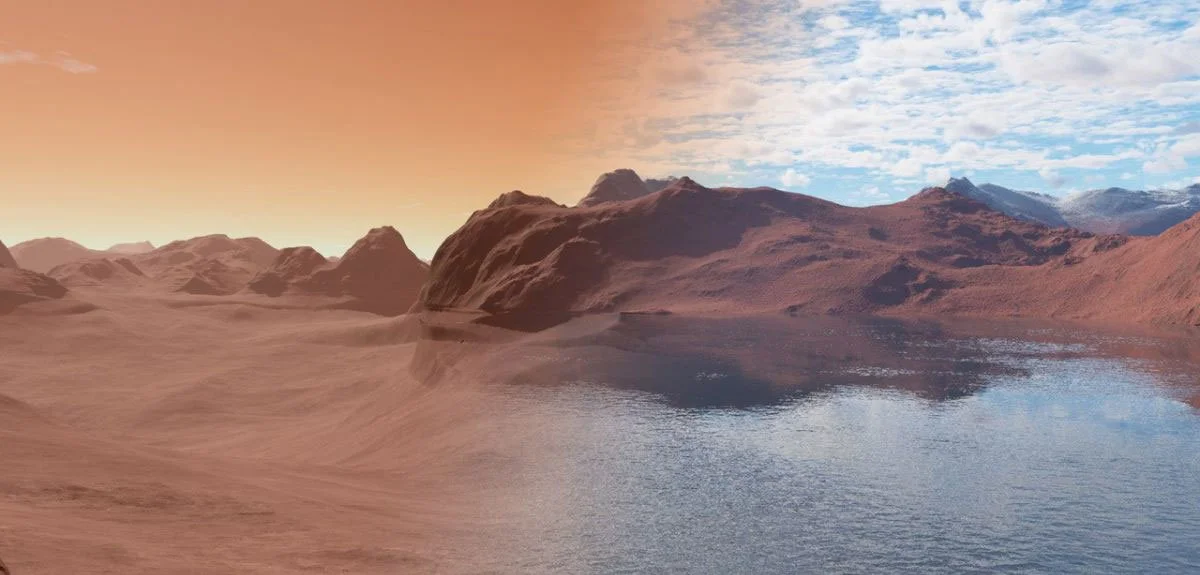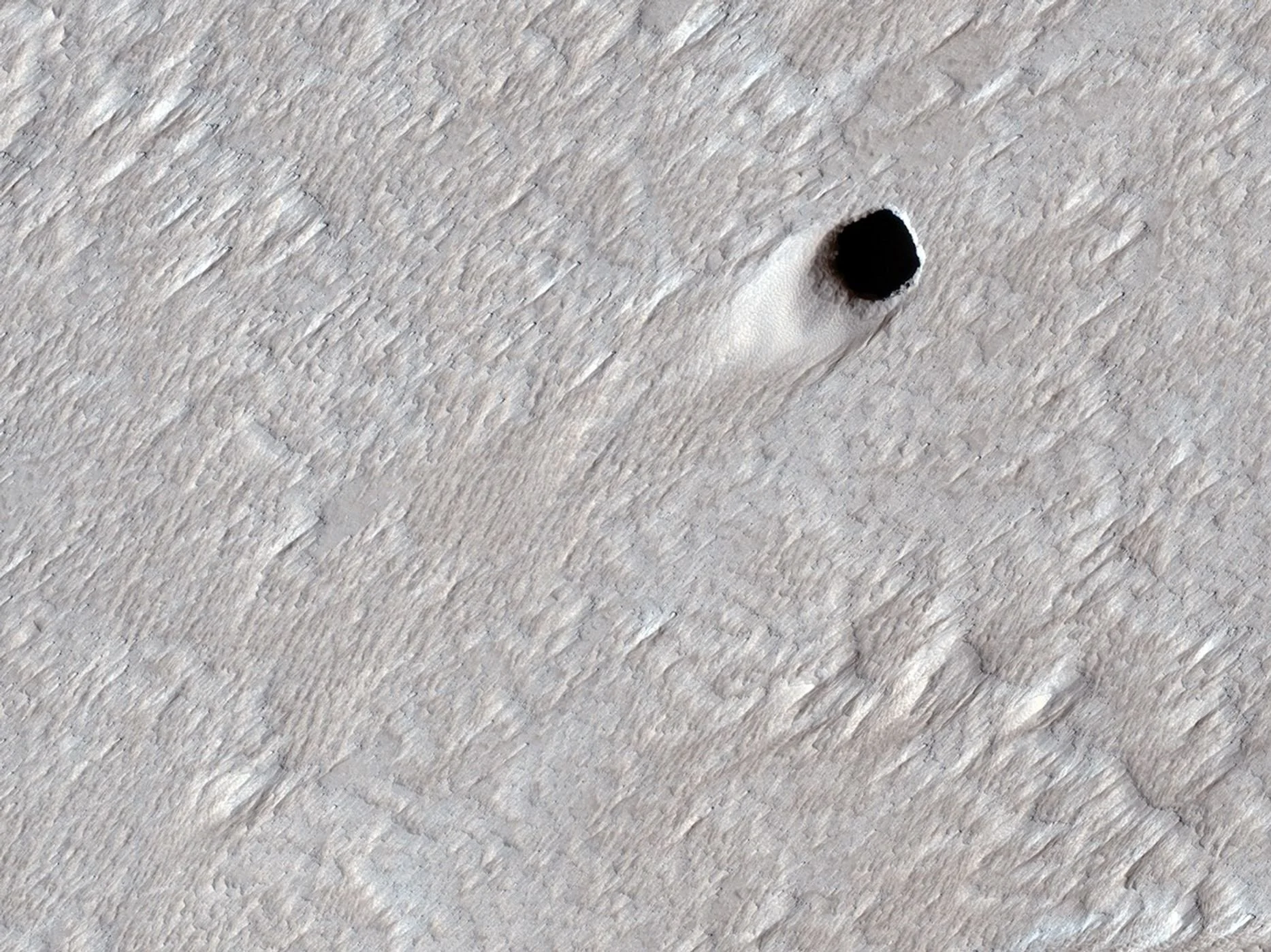(The surface of) Mars ain’t the kind of place to raise your kids: A new, indigenous deep terrestrial subsurface microbiome
By Catherine Maggiori
Synopsis: This month at SAGANet, we’re discussing a new Nature Communications paper about a deep subsurface microbial community at Kidd Creek Observatory in the Canadian Shield. The taxa present may not be unique to fracking environments and could instead be native to a wide range of deep, isolated groundwater systems.
Author info: Dr. Catherine Maggiori is an astrobiologist and microbiologist. You can find her at the bench, attempting to set up a Bluesky account, or at the climbing gym.
An artist’s impression of the current Martian surface (left) and what parts of Mars may have looked like ~4 billion years ago (right). Credit: Jon Wade.
The surface of Mars is freezing, desolate, and largely inhospitable. But it wasn’t always this way; we know that during the Noachian Period (4.1 - 3.7 bya), Mars was warmer and wetter, which could have been a persistent climatic condition or something that occurred in transient periods.
While “warmer and wetter” is relative (think more like Earth’s polar tundras, rather than a tropical beach), if life emerged on Mars during this time, it could have survived and even thrived on the surface.
So where could it have gone as Mars transitioned to its current barren state?
Any putative extant life would have had to retreat away from the Martian surface, away from subzero temperatures, hyper-aridity, and high solar radiation, and into refugia like lava tubes, within rocks as endoliths, or deep underground.
We know that microbes can live kilometers below the surface of the Earth, isolated from surface conditions, communities, and nutrients. They exist and have developed independently, potentially providing context on how any potential life may be doing the same thing in similar environments on Mars or other extraterrestrial habitats.
The study site used in this December 2024 Nature Communications Earth & Environment paper is particularly well-suited for studying biosignatures, metabolic strategies, and subsurface microbiomes: the Kidd Creek Observatory (KCO) near Timmins, Ontario. KCO operates out of Kidd Creek Mine, the world's deepest base-metal mine below sea level, mining 9.8 km below Earth’s surface.
Kidd Creek is located in a massive sulfidic ore deposit on the traditional territories of the Anishinabewaki and Cree and contains the oldest flowing water on Earth. At 2.4 km below the surface, the KCO water system has a mean residence time of more than a billion years, with its youngest waters estimated to be ~150 million years old. As such, there’s been a lot of time for the water to interact with the rock around it, making it highly salty and rich in molecular hydrogen from serpentinization. Abiogenic methane, hydrocarbons, and dissolved sulfate are also present in the fracture fluids.
Previous studies have shown that KCO waters contain a low abundance (103 - 104 cells/mL) microbial community of moderate halophiles, sulfate reducers, and some homoacetogens. The present study from Ford et al. is the first genomic and phospholipid investigation of the KCO fracture fluid microbial community.
Fracture water (FW) was passively collected from biosampler units at two flowing boreholes (12261 and 12299) at 2.39 km below surface level to produce 3 FW samples for each borehole (FW12261 2017A, FW12261 2017B, *FW12261 2018, FW12299 2017A, FW12299 2017B, and FW12299 2018), as well as two samples of a biofilm growing on the adjacent mine wall to borehole 12261 (see sampling schematic below). Biosamplers were in place for 6 - 8 months before collection in 2017 and 2018 (tandem biosamplers were deployed in 2017). Samples were compared with service water used for mine operations.
From Fig. 1 in Ford et al. Graphic illustration of the Kidd Creek Observatory sampling arrangement at 7850 ft below the surface.
Geochemically, the FW from both boreholes is highly saline and neutral, containing similar geochemical species. Conversely, the service water was geochemically and isotopically distinct, indicating no mixing between its original surface lake and the FW. This distinction was further supported in the phospholipid fatty acid (PFLA) profiles, where the service water was significantly different from the other FW and biofilm samples.
In terms of phylogeny, the most abundant taxa present in the borehole and biofilm samples were from Sphingomonas echinoides and Candidatus Frackibacter, and possessed no significant correlation with those taxa present in the service water. Candidatus Frackibacter, in particular, was completely absent from service water sequence data.
From Fig. 4 of Ford et al. Bubble plot depicting the relative abundance (≥1%) of taxa present in the KCO and service water samples. Sample *FW12261-2018 became detached from the borehole during sampling and samples FW12261-2017A and 2017B failed to amplify.
S. echinoides is an aerobe that likely lives off of the dissolved organic carbon in the FW system and may indicate samples with increased exposure to the ambient mine (i.e. biofilm 2017 and *FW12261-2018 which detached from its borehole).
Candidatus Frackibacter is a member of the family Halobacteroidaceae, halophilic obligate anaerobes, and was previously detected in fracturing wells (hence the name “Frackibacter”). Originally, the phyla was inferred to be the result of hydraulic fracking fluids creating and sustaining new microbial ecosystems, but the use of recycled lake water as service water, rather than fracking fluid, in this work suggests that Candidatus Frackibacter is a native member of the KCO subsurface water system.
Previously, it was suggested that Candidatus Frackibacter subsisted on nutrients (particularly glycine betaine) from fracking fluids, but given the putative indigenous nature of Candidatus Frackibacter in KCO and the lack of nutrients in the service water suggests that this taxa is metabolizing something else.
Using the stable carbon isotopic signature of the Candidatus Frackibacter PLFA (δ13CPLFA) profile and the mine environment’s δ13C patterns, Ford et al. show that this bacterium may be using sedimentary organic carbon (SOC). In this part of the Canadian Shield, refractory carbon layers can release DOC as biphytanes and hopanes; by using this kind of refractory organic carbon, Candidatus Frackibacter may be able to sustain itself within these kinds of isolated, extreme subsurface water systems over geological timescales.
If Candidatus Frackibacter is indeed not unique to fracking systems and instead an indigenous member of the deep subsurface microbial community, these results imply that similar habitats could host their own cloistered and active microbiomes elsewhere in our solar system (like a Martian lava tube system).
A lava tube opening in Arsia Mons on Mars.




